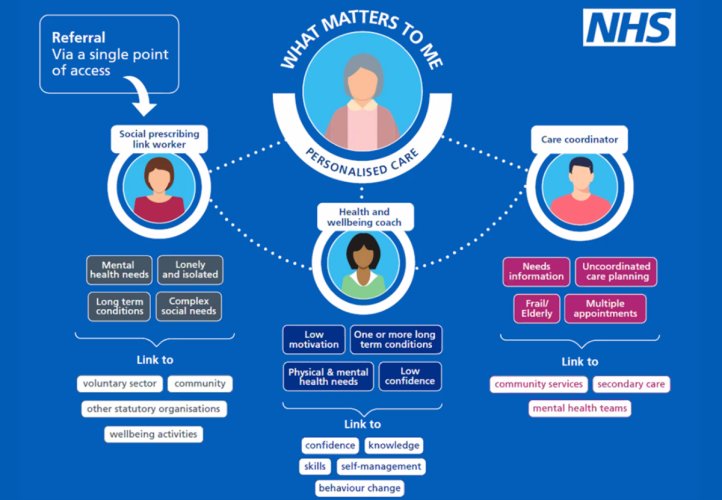Sign up
for our
Newsletters
Subscribe here


Physical Activity Social Prescribing
As a physical activity provider, it is important to understand what social prescribing is and how you can best connect and offer movement as part of a personalised care plan. This page will explain the different personalised care roles and the value that physical activity can bring to social prescribing.
What is Social Prescribing?
The National Academy for Social Prescribing (NASP) refer to Social Prescribing as ‘a way of actively connecting people to activities, information, and resources to help address an unmet health and wellbeing need or risk’. - NASP. NASP is a national charity with a goal to ensure social prescribing thrives across the whole country, connecting communities and working closely with Sport England and UK Active to connect sport, physical activity and the health system. You can find a NASP-hosted webinar showing the evidence of exercise interventions for those with long-term health conditions.
Social Prescribing has the potential to relieve pressures on the NHS, tackle some of the most significant health inequalities, and ensure individuals can receive bespoke non-medical support when and where they need it. One in five GP appointments are about wider social needs rather than medical issues, stressing the importance that social prescribing can play in improve the quality of one’s life.
"Social Prescribing is an approach that connects people to activities, groups, and services in their community to meet the practical, social, and emotional needs that affect their health and wellbeing" - Sport England
How do we identify between personalised care roles?
Personalised care is all about meeting the unique needs of each individual, rather than adopting a one-size-fits-all approach. It involves putting patients at the centre of their care by considering their specific preferences, values, and circumstances and offering the individual a chance to make decisions about their own care in a way that aligns with their lifestyle and goals. The following roles are in place to support individuals create their own personalised plan and it helps to identify where each of these roles are situated within the health sector. These roles can often get confusing with lots of different job titles, sitting in different health teams, so the below can support you navigating this complex world:
Care Coordinators work alongside GPs and other primary care professionals within Primary Care Networks (PCNs) to provide extra capacity, support and expertise to patients who are having clinical conversations. They support the individual in creating a single personalised care plan, whilst providing guidance on appointment booking, training/employment opportunities, as well as identifying opportunities for benefits and personal health budgets where appropriate.
Health & Wellbeing Coaches use health coaching skills to establish a one-to-one partnership with individuals in their care, to improve levels of ‘patient activation’. They are experts in behaviour change and focus on improving health-related outcomes by working with people to set personalised goals and change their behaviours.
Social Prescribing Link Workers are an integral part of multi-disciplinary teams in PCNs, assisting in delivering non-medical care through referrals and connecting patients to community services – working in partnership with other agencies, local authorities, and community groups.
What value can the physical activity sector add to social prescribing?
When we take part in physical activity, we develop skills that help in every aspect of life. We find new friends, and we grow in confidence. We reconnect with ourselves. And we get our lives back on track.
From a health perspective, the case for physical activity is clear:
It lowers the risk of conditions including cancer, dementia, heart disease and stroke
It can lessen the risk of type 2 diabetes by 30-40%
It boosts mental wellbeing, reduces anxiety and depression, connects people, and enhances happiness and self-esteem
It helps people living with chronic illness to manage their condition
It plays a vital role in maintaining a healthy body weight, getting a good night’s sleep, and feeling more energised
And it can help you cut back on unhealthy habits like smoking, so that you live better, for longer
Green Social Prescribing
The practice of supporting people to engage in nature-based interventions and activities to improve their mental and physical health. These could include local walking schemes, community gardening projects, conservation volunteering, green gyms, open water swimming or arts and cultural activities which take place outdoors. Likewise, blue social prescribing describes engaging in activities in/near/around water.
Useful Links
For further details about embedding physical activity into social prescribing, please contact hsphealth@herts.ac.uk

Our Funding Newsletter keeps you up to date with all the latest news and funding pots available.
If you have a generic question please email the Herts Sport & Physical Activity Partnership team: hspinfo@herts.ac.uk





